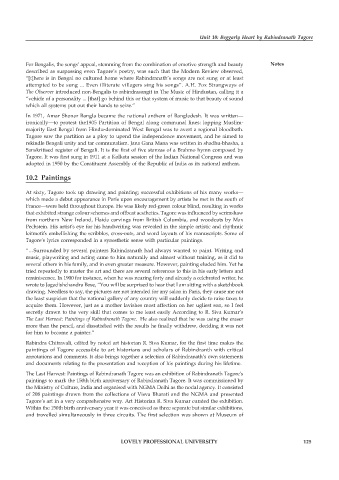Page 130 - DENG202_ELECTIVE_ENGLISH_III
P. 130
Unit 10: Beggarly Heart by Rabindranath Tagore
For Bengalis, the songs’ appeal, stemming from the combination of emotive strength and beauty Notes
described as surpassing even Tagore’s poetry, was such that the Modern Review observed,
“[t]here is in Bengal no cultured home where Rabindranath’s songs are not sung or at least
attempted to be sung ... Even illiterate villagers sing his songs”. A.H. Fox Strangways of
The Observer introduced non-Bengalis to rabindrasangit in The Music of Hindustan, calling it a
“vehicle of a personality ... [that] go behind this or that system of music to that beauty of sound
which all systems put out their hands to seize.”
In 1971, Amar Shonar Bangla became the national anthem of Bangladesh. It was written—
ironically—to protest the1905 Partition of Bengal along communal lines: lopping Muslim-
majority East Bengal from Hindu-dominated West Bengal was to avert a regional bloodbath.
Tagore saw the partition as a ploy to upend the independence movement, and he aimed to
rekindle Bengali unity and tar communalism. Jana Gana Mana was written in shadhu-bhasha, a
Sanskritised register of Bengali. It is the first of five stanzas of a Brahmo hymn composed by
Tagore. It was first sung in 1911 at a Kolkata session of the Indian National Congress and was
adopted in 1950 by the Constituent Assembly of the Republic of India as its national anthem.
10.2 Paintings
At sixty, Tagore took up drawing and painting; successful exhibitions of his many works—
which made a debut appearance in Paris upon encouragement by artists he met in the south of
France—were held throughout Europe. He was likely red-green colour blind, resulting in works
that exhibited strange colour schemes and offbeat aesthetics. Tagore was influenced by scrimshaw
from northern New Ireland, Haida carvings from British Columbia, and woodcuts by Max
Pechstein. His artist’s eye for his handwriting was revealed in the simple artistic and rhythmic
leitmotifs embellishing the scribbles, cross-outs, and word layouts of his manuscripts. Some of
Tagore’s lyrics corresponded in a synesthetic sense with particular paintings.
“…Surrounded by several painters Rabindranath had always wanted to paint. Writing and
music, playwriting and acting came to him naturally and almost without training, as it did to
several others in his family, and in even greater measure. However, painting eluded him. Yet he
tried repeatedly to master the art and there are several references to this in his early letters and
reminiscence. In 1900 for instance, when he was nearing forty and already a celebrated writer, he
wrote to Jagadishchandra Bose, “You will be surprised to hear that I am sitting with a sketchbook
drawing. Needless to say, the pictures are not intended for any salon in Paris, they cause me not
the least suspicion that the national gallery of any country will suddenly decide to raise taxes to
acquire them. However, just as a mother lavishes most affection on her ugliest son, so I feel
secretly drawn to the very skill that comes to me least easily According to R. Siva Kumar’s
The Last Harvest: Paintings of Rabindranath Tagore. He also realized that he was using the eraser
more than the pencil, and dissatisfied with the results he finally withdrew, deciding it was not
for him to become a painter.”
Rabindra Chitravali, edited by noted art historian R. Siva Kumar, for the first time makes the
paintings of Tagore accessible to art historians and scholars of Rabindranth with critical
annotations and comments. It also brings together a selection of Rabindranath’s own statements
and documents relating to the presentation and reception of his paintings during his lifetime.
The Last Harvest: Paintings of Rabindranath Tagore was an exhibition of Rabindranath Tagore’s
paintings to mark the 150th birth anniversary of Rabindranath Tagore. It was commissioned by
the Ministry of Culture, India and organised with NGMA Delhi as the nodal agency. It consisted
of 208 paintings drawn from the collections of Visva Bharati and the NGMA and presented
Tagore’s art in a very comprehensive way. Art Historian R. Siva Kumar curated the exhibition.
Within the 150th birth anniversary year it was conceived as three separate but similar exhibitions,
and travelled simultaneously in three circuits. The first selection was shown at Museum of
LOVELY PROFESSIONAL UNIVERSITY 125

